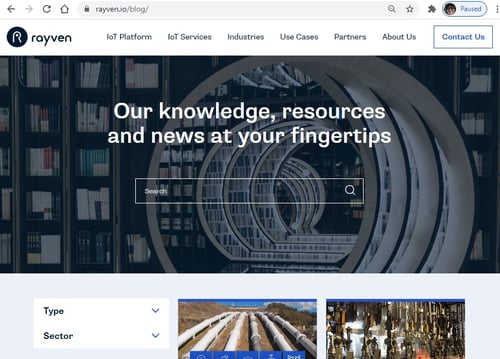Global Mining Review
Double Down on Data.
Article
Phillip McBride, I4 Mining and Rayven, Australia, reviews how the way to achieving emissions, ESG, or any Industry 4.0 and automation goals starts with data.
White & Case’s recent ‘Mining & Metals 2022’ report found that – low and behold – environmental, social, and governance (ESG) concerns topped the risks that senior executives in the mining sector see for the coming year. As the same report did last year. As did Deloitte’s latest ‘Tracking the trends 2022’ report, and EY’s ‘Top 10 Business Risks and Opportunities for Mining and Metals in 2022’.
These reports all also found that there were significant benefits for miners in investing in solving ESG challenges – not just through grasping the nettle and beginning their work on emissions reductions ahead of 2050 – but in also delivering efficiencies on costly inputs (such as by reducing energy usage), finding new sources of capital, seizing optimisations in real time before potential gains are lost, and proving stakeholder credentials to unlock new sites and extend the lifespans (or scope) of existing ones.
The data is in: ESG is not just the zeitgeist, but the organisational imperative. So how can automation and artificial intelligence (AI)-led intervention play a significant role in helping mining and metals companies achieve their ESG objectives? The answer(s) can be simple, but only if the right foundational pieces are in place and businesses are looking to solve challenges now, not tomorrow.
The data (and execution) challenge.
A lot of the issues that relate to tackling many ESG or transformation challenges, but emissions in particular, begin with data. More specifically:
- There is a lack of access to credible, accurate data of what is or is not happening.
- These data points are not being effectively analysed or made available in a timely manner.
- Businesses do not have the technological ability to do something about the data they are seeing in real time on the ground (i.e. before optimisations are lost or a failure leads to a much bigger problem).
Not only does this lead to general inaction (‘where’s the evidence?’/‘I don’t believe the data’/‘these are only estimates rather than actual measures’) and a disjointed approach to achieving strategic goals, but it prevents organisation’s from leveraging Industry 3.0 (automation) and Industry 4.0 (AI-led interventions) to tackle the challenges that they face.
The Internet of Things (IoT) and AI revolution of recent years, however, has created an answer to the aforementioned problems. It comes through the adoption of a foundational piece of technology that is critical if businesses are to create a true digital mine and find answers to the difficulties that they are facing with ESG.
Getting a complete, credible, real-time picture from existing sources.
Businesses in every sector have significant data problems at present. Not only are key measures missing because organisations simply are not leveraging the IoT in-field technology needed to collect them, but key data exists in different IT systems or software as a service (SaaS) suites, is stuck in operational and physical technology (think SCADA or other machinery software), and cannot be linked and looked at alongside relevant third party data (such as weather forecasts) that are being used on sites and in HQ.
Fundamentally, interoperability is a massive challenge, but so is the merging of data sets and the analysis of them in context with each other to provide a complete picture of what is going on in real time; the forming of predictive insights as to what is (or is not) about to occur based on that picture using machine learning; and the development of the functionality to take action, execute, or programme actions based on what the data is showing then and there.
To connect these silos and make use of real-time data via automations, as well as AI and human-led intervention, what is required is a single piece of technology that is capable of 100% interoperability, connecting to every system and data source. It should have the functionality to analyse all of the data that is coming from them (plus other systems or data sources inside and outside an organisation), in order to identify trends, relationships, and insights hidden in the ‘Big Data’ that is being accumulated in real time. It should then also be programmed to take direct action based on custom business logic (automations), or via AI-led intervention, to improve and optimise processes, work schedules or anything else on an ongoing basis, based on changing variables and performance.
What is being described here is a new generation of technology platform called a real-time data consolidation and AI + IoT solution delivery platform. It is critical because it is the one place in an organisation where all of its data (both historical and real-time, from any system, sensor, or data lake) can flow and be standardised for analysis in real time, where machine learning algorithms can be leveraged, and where cross-functional decisions can be orchestrated and executed: it is a Mining 4.0 brain for every business.
Real-world automation and Industry 4.0 ESG applications.
The creation of a reliable, credible real-time view of organisational performance unlocks numerous applications for enhancing ESG performance across the entire mining lifecycle and operational lifetime, which can all be tailored to individual site and business needs.
The following is an outline of just some:
- Accurate carbon accounting: By accurately monitoring and tracking carbon emissions by integrating data from in-field devices, advanced plant and business systems, it is easy to create a real-time view of SDGs, TCFDs, or any other key environmental metrics at a moment’s notice. Taking it further, it makes it possible for businesses to compare current performance to benchmarks and, through the use of machine learning, predict and model future performance based on asset, personnel, sites, and entire operational changes (digital twin).
- Real-time environmental monitoring: An Industry 4.0 consolidated data and AI + IoT platform enables miners to unite real-time data feeds from sensors on site, with internal systems and third-party data sources to deliver readily accessible, accurate, real-time environmental metrics. This can be used at all stages of a mine’s lifetime, establishing better baseline values and tracking post-close remediation success. It also unlocks the potential for many other benefits, such as: fault and leak detection, geo-fencing, reduced energy consumption, operator environmental and safety scoring, proximity real-time alerts, compliance guidance, remote tracking, plant class comparisons, pinpoint environmental areas of concern, improved maintenance regimes, and much more.
- Improved environmental and social impact assessments (EIAs and SIAs): The collection of accurate data from sites and the real-time monitoring of environmental performance over time, based on different operational factors, enables miners to establish baselines more accurately for future EIAs and SIAs, as well as better plan operations and post-closure remediation efforts at an individual site level.
- Aggregated risk profiling: The platform enables the creation of algorithms that can better explore the impact of certain activities on others to establish true risks via aggregated profiling. For example, the impact that atmospheric conditions can have on a tailings dam and when that becomes a problem.
- Cross organisational analysis: With accurate, standardised analysis of asset, function and site performance in different mines and facilities, it is possible to uncover best practices, identify superior plant, as well as identify areas for improvement based on large data sets. This improves short-term site level metrics, but also improves the environmental results via longer-term optimisations (e.g. better staff training) and takes away barriers that exist between departments and units.
- Immediate, automated mitigation and remediation: Real-time data can provide miners with rapid, effective direction (plus automated interventions) should an unexpected environmental incident occur (or be about to). Learning from modelling and previous performance, the platform can leverage situational data and find ways to better mitigate unwanted outcomes or, better still, monitor critical environmental measures in real time to prevent breaches and harm from ever occurring.
- Better waste management: Spill, tailings, and other waste, if improperly handled, can have serious environmental impacts. A data consolidation and AI + IoT platform can enable miners to monitor how it is being handled in real time, accurately scrutinise process adherence, plant and personnel performance, and be used to reconcile tonnage across supply chains and track whether waste is being treated/incinerated/stored correctly.
- Establish real-time employee safety and environmental scores: Through the analysis of real-time data monitoring, via technologies such as drones, wearables or other in-field sensors, it is possible to monitor employee performance based on individual aspects of their role, such as how safe they are being within operational norms. This could help identify when, for example, an employee is distracted, regularly following rules, or could be about to make a mistake that would lead to serious environmental consequences.
Do not wait for the grass to grow.
The path to true digital transformation and achieving ESG (or any other) business objective will be lined with lots of use case-specific technologies that improve the abilities of individual elements of mining operations, whether it is better water pumps, electrified forklifts, or better risk analysis of environmental threats.
All of these technologies, including existing and legacy ones, need a place where the data that they are using and creating can come together and be put to use to work together and achieve the same goals – it is the difference between improving a single measure or metric vs delivering holistic change that can achieve tangible, measurable business objectives.
What is so beneficial about a real-time data consolidation and AI + IoT solution delivery platform is that it is not necessary to be chasing ‘transformation nirvana’ and have huge resources to get started with it – in fact, it works better if this is not the objective.
Start with something small that can be measured and improvements assessed, such as forecasting when critical machinery that is needed to prevent polluted material from entering groundwater systems will break down or fail at a particular site. From there, build in rainfall data and predict when challenges may occur and/or leverage wearables to inform those on site when a failure is going to happen, so that they can do something about it. Next, copy it across sites, and then build a similar system for dust, noise, carbon dioxide and methane emissions, and anything else.
Start small, prove return on investment and then scale, but most importantly: start, because the future is not that far away.
I4 Mining is a sustainability technology provider to the mining sector, offering ready-to-deploy ESG solutions that help miners to succeed both strategically and operationally without ever getting in the way of good business.
Our solutions enable you to easily develop strategies, deliver accurate sustainability metrics and reports in real-time, improve sustainability and business performance, as well as make predictive analytics and forecasts part of your everyday so that you can reduce risks and optimise from mine-to-market.
Speak to us today to book a demo and discover how you can get started on your digital sustainability journey.
Featuring:
Phillip McBride
CSO & Technologist @ Rayven
phillip@rayven.io
LinkedIn
Want to know about industrial AI + IoT more broadly?
If you'd like to find out more about the technology that underpins all of our digital mining solutions, other industrial uses of AI + IoT, or are eager to get into the detail of precisely what AI and IoT technology are then visit the Rayven blog.


